The art assets almost look like they were developed for the DS, but I know there's no way the DS could have handled that many polygons in the background. I wonder if they switched platforms after they started development.
Shinobi Review
|
|
See PixlBit's Review Policies

On 12/13/2011 at 12:00 PM by Patrick Kijek Once upon a time, one of the toughest games got its rightful sequel. It’s now. |

Average graphics and cheap moments take away some luster from an otherwise rewarding experience. Only the most hardcore need apply, but they will appreciate the achievement from succeeding in Shinobi.
Out of all the 3DS titles released this year, Shinobi is the most likely to become a hard-to-find cult classic. Even with all of its faults, hardcore fans will find more than enough content to feel fulfilled. The developers at Griptonite have reinvigorated a dormant series that has stayed true to its roots as an unforgiving, relentless, combat-based platformer.
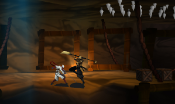
Like the Super Shinobi games, Shinobi 3DS begins in feudal Japan. However, the setting explodes quickly when our ninja somehow time travels into the distant future. For the rest of the (mostly unexplainable) plot, Jiro battles well-equipped soldiers with various guns, swords, and rockets. Jiro is a descendant and from the same clan as Joe Musashi, the original ninja from the 1987 Shinobi arcade game. You just won’t find any information like this - or who Sarah is, a mysterious female only seen between levels - during the cutscenes. You won’t find any information about the Zeed army either.
Splicing in random messages from seemingly nowhere, Griptonite’s story knows how to screw with your brain. The scenes don’t seem to make sense initially, so you may have to read their descriptions in the Awards Vault. These animations do have an amusing humor, although it might be hard to crack a smile until after you’ve beaten the game on beginner difficulty. They are shoddily made, hopefully as a nod to the poorly dubbed martial arts movies and anime of the 20th century.
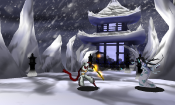
Enemies include flying machines and spikes with huge hit boxes throughout the stages. The spikes in particular have much less margin of error than they appear in the later stages of the game. They will make you super mad. If you spend the hours to become one with the stilted way Jiro controls as a platformer, you still might fall to your death from flying bullets during your leaps across crevices. He even might start to feel slick. By the time you reach one of the bosses, it’ll feel like a blessing and a load off of your fingers. The set pieces during the boss sequences showcase the average graphics to the best of their ability: magic wielding ice princesses, helicopters, and even a shark will make you smile with the game’s ridiculousness.
Some of the set pieces and bosses are Griptonite’s homage to the classic Shinobi games like Shinobi III: The Return of the Ninja Master. Others have been bred from a creativity all their own. Each enemy does have a set way of attacking, so parrying their attacks shouldn’t be as difficult as it turns out. Your ability to parry and defend these enemies will best be trained through a beginner run. Too bad some of these awesome battles have been accompanied with frame rate issues, slowdown, and a game crashing bug in one case.
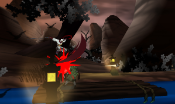
I recommend all players start off on beginner difficulty with infinite lives, since the tougher difficulties require you restart the entire level when you run out of lives. Shinobi falls to his death more than anything else. As an experienced veteran at platforming, some of these deaths just seemed too cheap. A ninja should be nimble, but this is one of the biggest problems with Shinobi. There are certain jumps you might have to practice for hours on the final stage, and you still have to get a little lucky to pass through the challenge.
The action in the heart of these levels is broken up with mid-level set pieces. These mostly mix up an otherwise unvaried, repetitive set of enemies with a section where Jiro rides a horse, surfs through water with tilt controls, and even on top of a jet. It’s too bad more of the sections couldn’t play more like the jet section, because it had the most pronounced 3D in the game, not to mention one of most fun music tracks. You’ll probably like about half of these bonus sequences, depending on your personal preference. A more exciting use of this type of gameplay could make a portable sequel to Shinobi much better. The ability to play these in some form of expanded mini-game could add to the experience too, since most of the content does not lend itself to portability. The levels are long (some will take upwards of 30-60 minutes on your first try, depending on skill) and will make you shout at your system in public.
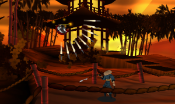
Despite the frequent platforming cheap deaths, the hardcore gamer or fan of the series will feel the wealth of content outweigh the shortcomings of Shinobi. The replayability (partially aided by dying so much initially) is more than enough to hold a player’s interest for a year: there is a deep scoring system where you are eventually graded from C-A depending on your expertise, and an S for your very special runs. Your best runs can be saved to Shinobi’s replay theater, a feature you’ll be glad to have once you become versed enough in the game to tout your talent. It will take a mixture of spot-on defending, fearless swordplay, extended multipliers (increased by hitting enough enemies until you take damage, up to a maximum of x4), and using ninja magic at the correct moment in the level.
Jiro’s power can enhanced with four types of ninja magic - fire, earth, lightning, and water. Fire kills all normal enemies instantly, earth gives Jiro the ability to auto-parry (and more abilities like quicker attacking, although the tutorial doesn’t tell you), lightning is used for its defensive boost and invulnerability to spikes, water adds speed and jumping distance for a long period of time. These do a lot more than stated, adding a huge degree of flexibility and gameplay possibilities.
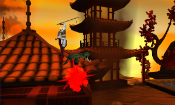
Various rewards can be unlocked by finding bonus coins and mastery coins in secret areas. The bonus coins unlock a Kunai Blitz bonus round, where you’ll get to throw unlimited daggers at ninjas running from one side of the screen to another. Bonus coins as well as mastery coins can be used to unlock a detailed history of the Shinobi games or purchase new weapons. Streetpass will even allow you to unlock one of thirteen challenge maps, either through passing another 3DS-wielding ninja or buying them for 20 Streetpass coins.
Like a ninja unseen and unheard, Shinobi’s difficulty, limited production, and nonexistent marketing for what was once a flagship franchise in the late 80’s will most definitely assure that it goes unnoticed. That’s probably the way Shinobi likes it. Only the most devout players will beat this game, and fewer still on its hardest difficulty. Everyone who does will think of it as one of their highest achievements, and add it to their list of cult classics. For the rest of the population, stay away. Stay far, far away.








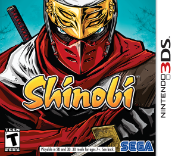


Comments